How To Take A Photograph And Turn It Into A Drawing On Photoshop
Accept you ever wanted to do something a little different with your photographs? Not stop with the simple click of the shutter and turn it into an actual digital painting? That is what I am going to teach you in this article. I know not everybody is a painter and while painting skills would be benign, yous really don't demand to be an creative person to do this. The photograph below is the result of me using Corel Painter to turn one of my photos into a digital painting. This tutorial contains some creative ideas and methods a photographer can use, even if they are not artistically inclined or have access to the same software every bit me. The idea is to open up your heed to the possibility of using your images in an creative way. I am using a bird in this tutorial, simply it could exist a pet, your friend, a family portrait or anything else.
Note: Past using the word "Artwork", the author is not challenge to transform images into "Art". We understand the true meaning of the word "Art" and we did not want to offend anyone with this article. If y'all find the word "Artwork" offensive, please replace it with the word "Painting".
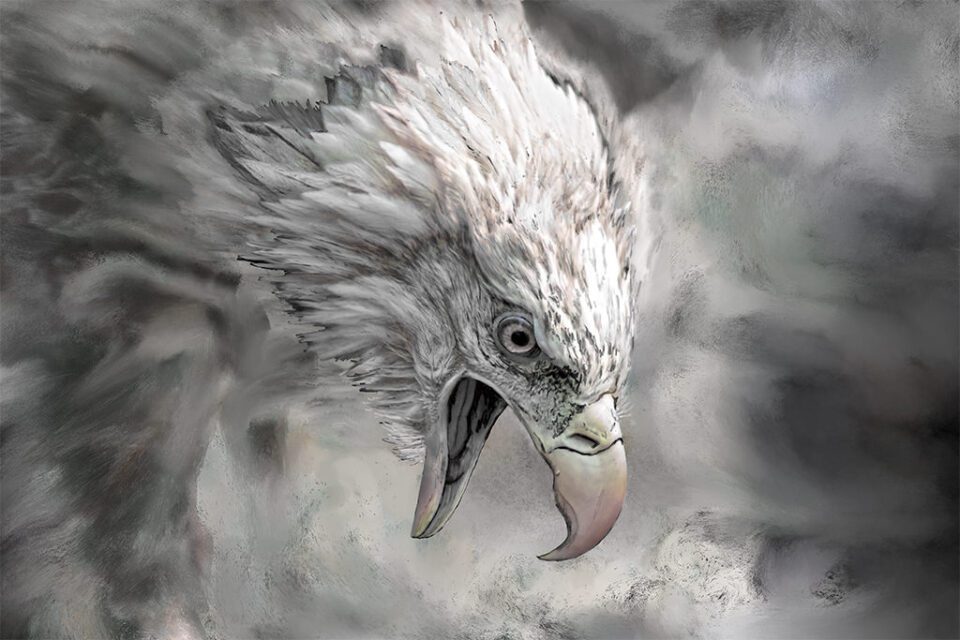
This isn't the verbal frame I used to create the artwork above (I don't seem to exist able to discover the original NEF file), this is a few frames later, but its close enough that you tin see what kind of photo the artwork was created from.
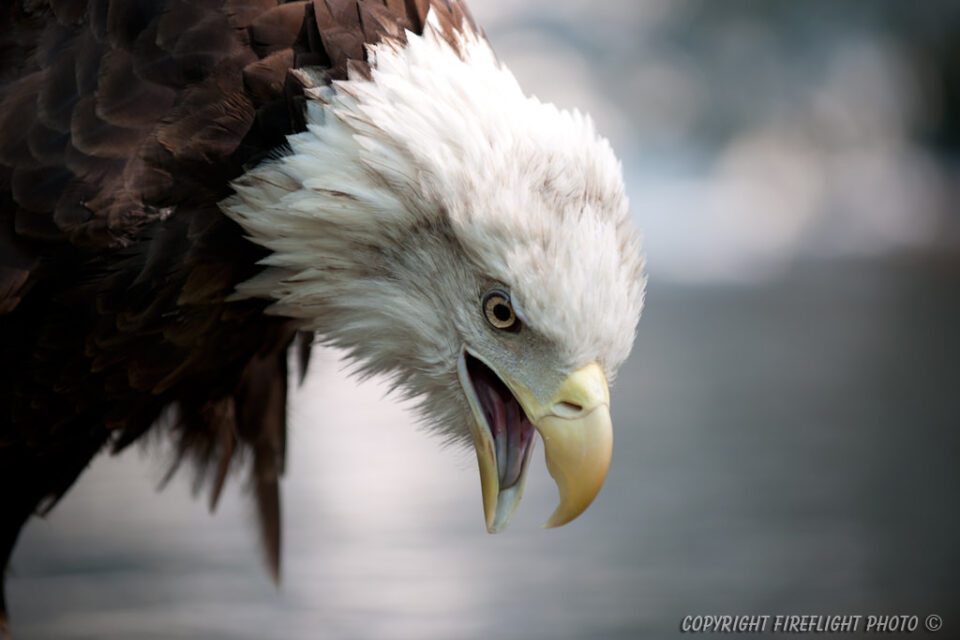
This tutorial goes through the process I apply to turn one of my photos (sometimes a non-keeper or below grade photograph) into a digital painting of that photo. The techniques here can exist used on family unit portraits or pet or any kind of photography. Go creative and give it a attempt. I originally created this tutorial for a friend of mine who has since passed away, so I recollect it's only plumbing fixtures this knowledge gets shared again.
Introduction
I accept been toying with digital paint programs for many years and take never really been totally satisfied with the results. Originally, I started using a programme called Gertrudis which later became known as GMX PhotoPainter. The pros of GMX are its cost and ease of use, it is really piece of cake for someone with very piddling experience to plough a photo into a piece of artwork and as you become comfortable with the bones tool set up and brushes, eventually yous will move to custom castor strokes and brushes.
Below is a wildlife instance of photographic artwork created using GMX. You will likely demand to meet the image at full resolution to see the strokes, seeing an artwork epitome downsized to a thumbnail blurs the distinction betwixt photo and artwork as the strokes almost seem to disappear.

So GMX does a good job at turning images into artwork, I accept used it many times to take photos of people and convert them to artwork which nosotros would and so impress on sheet. Like I hinted at earlier, the benefits of GMX are some of its auto stroke and car painting-like features, which are peachy for people who don't quite experience so comfortable with their painting skills. And however GMX also has a lot of power for those that want to control the stroke and color. Below are two more than samples from GMX. I would show the whole sample except I don't want to post the face up role of the painting, but this section of the painting shows plenty particular to give yous an overview of the results you can expect with GMX Photopainter. We will exist using Corel Painter in this tutorial. I spent the time on GMX considering it is much cheaper than Painter and smashing results tin can be obtained with information technology.

At some bespeak I wanted more command over my strokes and more features, of class these features means purchasing college priced software. The plan I have ever heard nigh every bit being outstanding for digital painting was Corel Painter. I purchased it and after at starting time existence overwhelmed with all its features, I soon got to know it. I have since upgraded to the latest version by Corel which is an extremely powerful tool. You don't accept to buy Corel Painter and a Tablet, they merely brand the process easier.
Just to show you lot what can be done creatively with a photograph, the following cougar collage has no painting involved at all. This collage was created by me from several of my cougar photos and all I did was use the threshold and selection and color removal tools of Photoshop to create this collage.
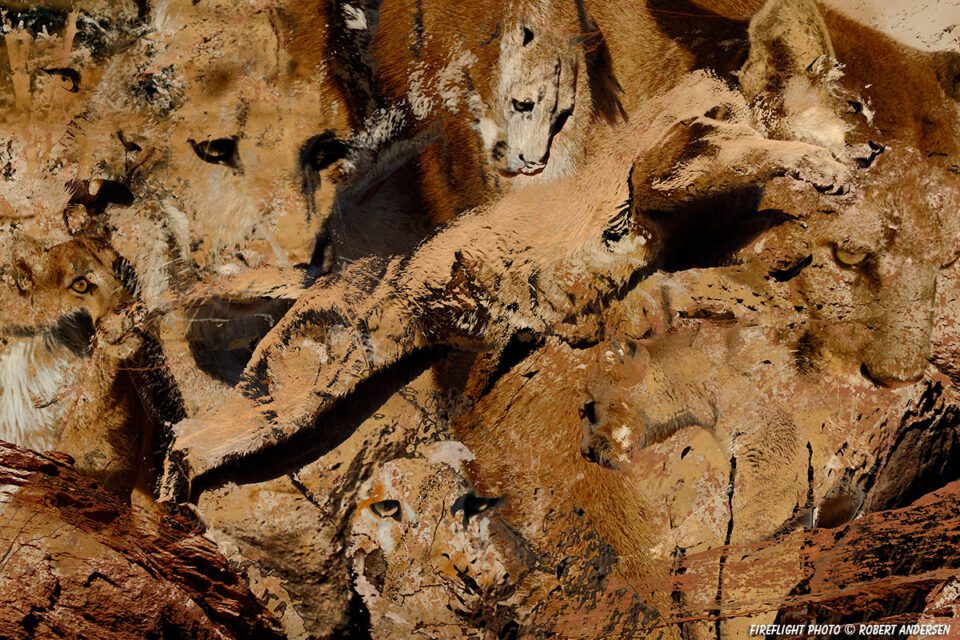
Photographers tin Help Painters
Even if y'all decide to stop reading this article at this point and decide y'all don't have a painter'south bone in your trunk, you can still exercise something to assistance these artists. 1 of my main problems growing up and trying to draw was getting good quality reference images, I am i of those artists that needs to await at something to draw it. Over the years I have had many denials of permission from photographers too worried about their epitome and copyright issues. Why not consider giving permission to use your photograph as a reference image? You don't have to give away the full resolution digital photograph. As an artist, I was quite happy to pay a fee to a photographer who let me use their images. Likewise keep in mind it doesn't have to be the consummate image. If, for example, I am request for permission to describe a moose photo you take, I just need to reference the moose (the animals themselves), which y'all can crop tight or cake out/delete the surrounding background before giving a smaller version to an creative person. Anyway, just continue in mind that many digital painters struggle and tin use all the help they tin become. Painting was actually ane of the principal reasons why I got into photography, I needed images I could use that I didn't demand to beg, borrow or steal for. Of course, photography has go my prime number passion since then.
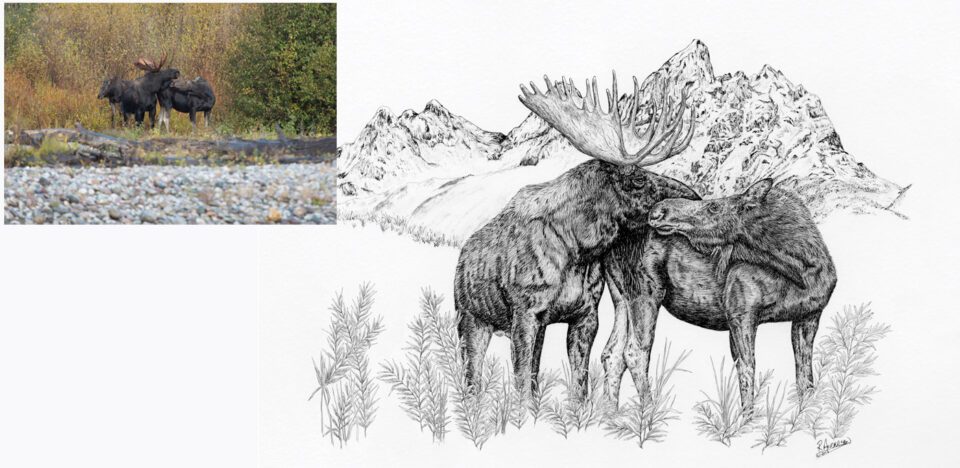
The above paradigm shows what is possible, fifty-fifty from a sub quality photo. Plainly you need painting skills for this item example as it was drawn using traditional pen and ink. I took an prototype I had photographed in Thousand Tetons that was likewise far away for my liking and lacked the particular I needed in a photograph, and turned it into a drawing. I have met many photographers who are out there to get great reference images, give them a paw if you become the chance.
Tools
I am not going to say that anybody who wants to convert photos to artwork needs a tablet, just I will say owning a tablet gives y'all ultimate command over the pigment strokes, the direction they take, the final result. Using a tablet and tablet pens combined with Corel Painter is almost like using a real paint brush.
The tablet of choice I use is a Wacom Intuos 4 (I recently upgraded from the Wacom Intuos iii). I also take 2 extra pens, the airbrush and art pen. The extra pens are non admittedly needed, you can draw keen with the basic tablet setup and it doesn't have to be a Wacom, but in my opinion Wacom make the best tablet on the market.
What y'all determine to use is upwardly to yous, but a tablet and pen make doing some tasks so much easier and intuitive than not having i. Not just in painting, but everyday use likewise while working with such programs every bit Adobe Photoshop.
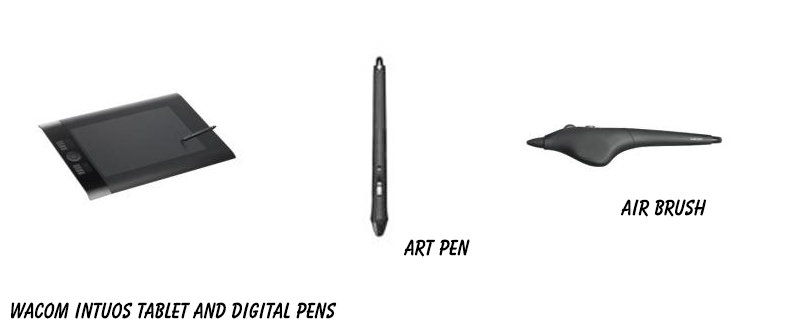
Let's Get Started
The way I use to get started is to find a photo with graphic symbol or something dissimilar well-nigh it, some action or beauty that inspires me to paint it. The photographs don't accept to be perfect. I actually regret deleting some of the photographs because I thought they were not good enough to post or sell. Many of those photographs would accept served as a great base for digital paintings.
Let's clear something up – I am not a painter and I don't take true painting skills outside of the digital world. I have done ink drawings and take some drawing skills but I am not an acknowledged creative person of any blazon. I prefer to by and large piece of work in black and white since I am simply drawn to the way black and white looks, just if yous adopt to do things in color, go for it. This tutorial is merely to get you started, ultimately yous need to find your own style, which is when you will become comfortable and produce paintings you are happy with.
For this tutorial I am going to paint an Aplomado Falcon. I chose the photo because I love the wingspread and considering it was not a photograph that could immediately be painted, it needed some editing to arrive paint-ready. This helps show what tin can be done with a photo y'all may think is not much good for anything.
So here is the original photo and the finished artwork beside it. It was taken while working with Jonathan Woods from the Raptor Project. Information technology is non a photo that I would ever use otherwise because of the arm and glove and all the unnatural objects in information technology. Hoowever, when painting I tin get rid of those and it is non a problem. The end outcome is an artwork which will never exist classified as photographically realistic. Remember, I chose a difficult initial photo to show you lot what can be accomplished.
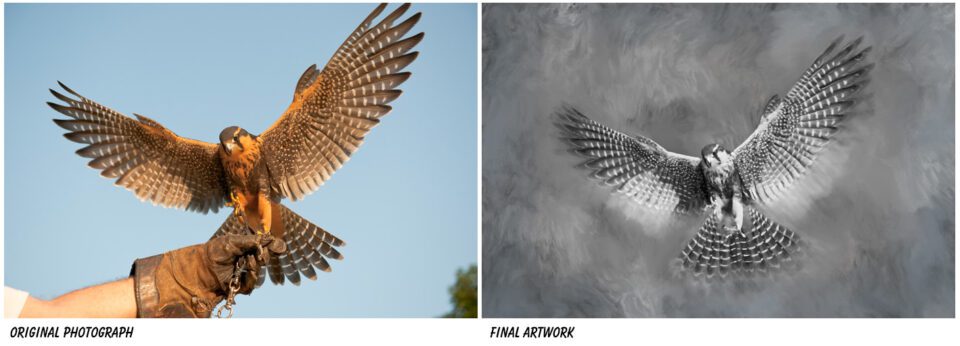
Preparing the Photo
Lets circle the bug to show what sort of editing and where is needed. You lot can bypass this section if your photograph has nada that needs fixing, obviously.
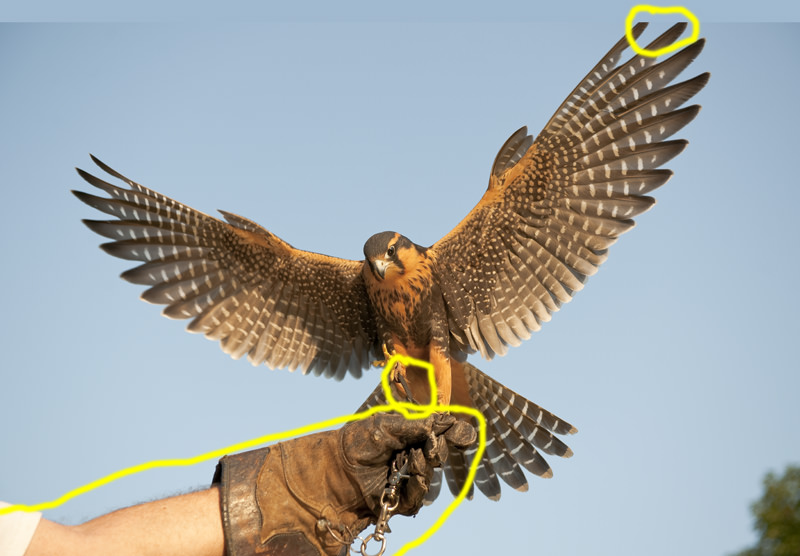
And here is what I establish needs to exist washed with the photo:
- Extend wing tips to complete where they are cutting off, which likewise requires extending the canvas
- Remove strap on birds left leg
- Remove the arm and glove (big edit)
- Removing the tree lesser right corner
Let'southward Start the Editing Process
- Extend the canvas at the top of the image to give you the actress space to consummate the wing and also take some clear infinite towards the edge of the artwork. Fill the extra space with sky color, sample a color close to the edge then yous won't have to alloy it in too much.
- Using the clone stamp tool on Photoshop or similar program, stamp in the balance of the wingtips every bit you would imagine them.
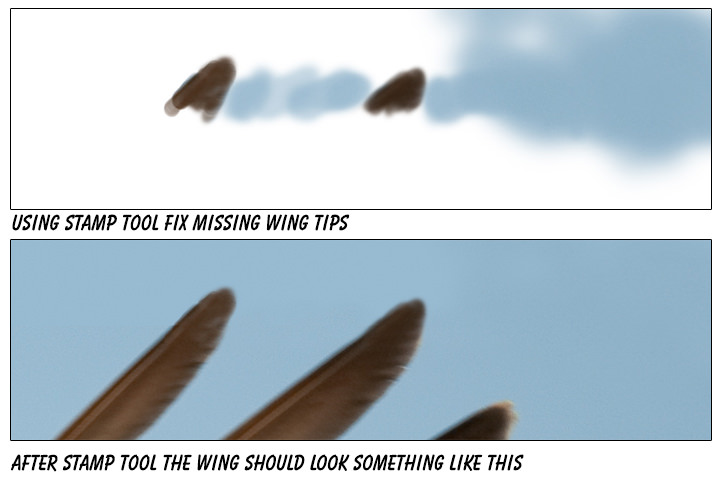
Aplomado Falcon Tutorial Steps 01 - Now let'south get rid of the arm and put most of the tail in place.
- Select the correct function of the tail and employ the Polygonal Lasso Tool in Photoshop, we are going to re-create that tail section, flip information technology horizontally, rotate it slightly to lucifer the bending and place it in position. This will create the left side of the tail.
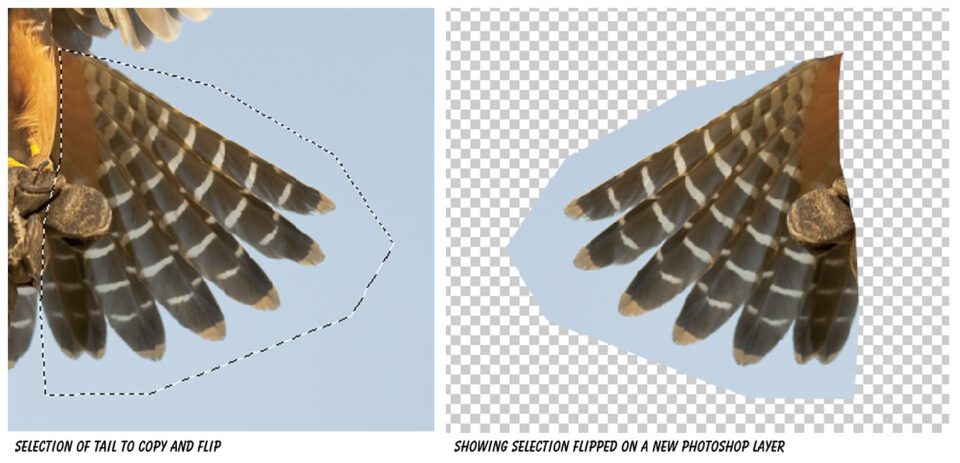
Aplomado Falcon Tutorial Steps 02 - Now rotate and position the newly created left wing, place it where you retrieve it looks the best.
- Next we volition go rid of all the background junk, the arm and the tree on the right, use either the clone postage stamp tool or just use the paintbrush tool in Photoshop to paint over the arm. Select the blue sky color close to the arm and so it matches; leave a lilliputian transparency on the tool and so it blends with the residual of the sky.
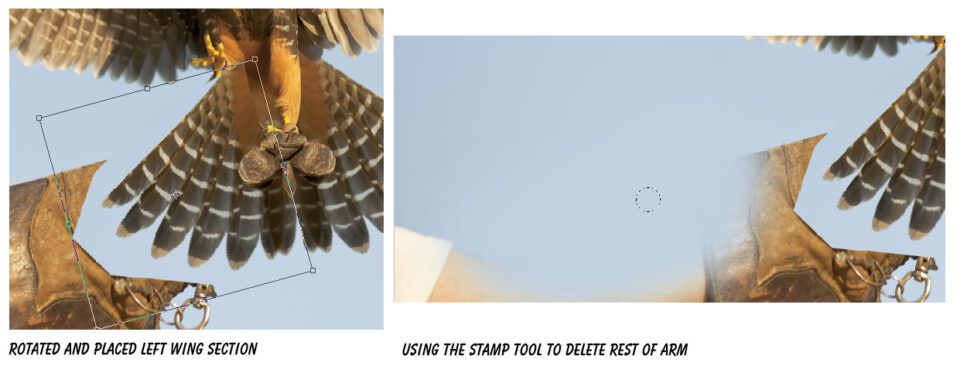
Aplomado Falcon Tutorial Steps 03 - Go on removing the arm and tree until yous are satisfied. The last consequence will wait something like the following:

Aplomado Falcon Tutorial Fly Stock-still - Now it gets a little tricky, nosotros need to remove the terminal remnants of the glove and draw in the right foot, it can all be washed with the clone stamp tool in Photoshop, think this is simply a reference picture to paint from, it doesn't have to be perfect.
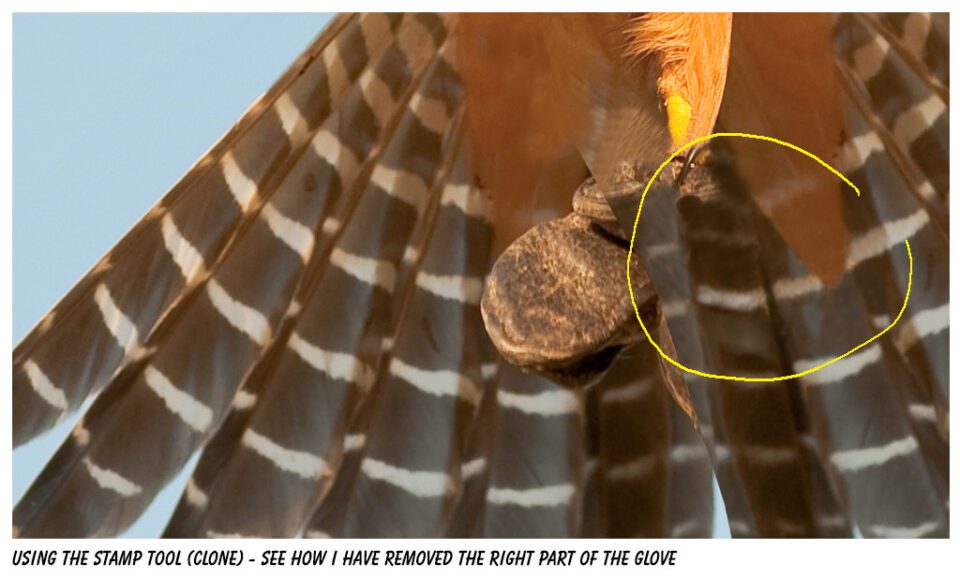
Aplomado Falcon Tutorial Steps 04 - Just proceed stamping and cloning until y'all are happy, even though the steps are non shown here, I used the good foot to create the missing human foot. I but copied, placed, manipulated it until I was happy.My final result of stamping and manipulating of the image looks like this:
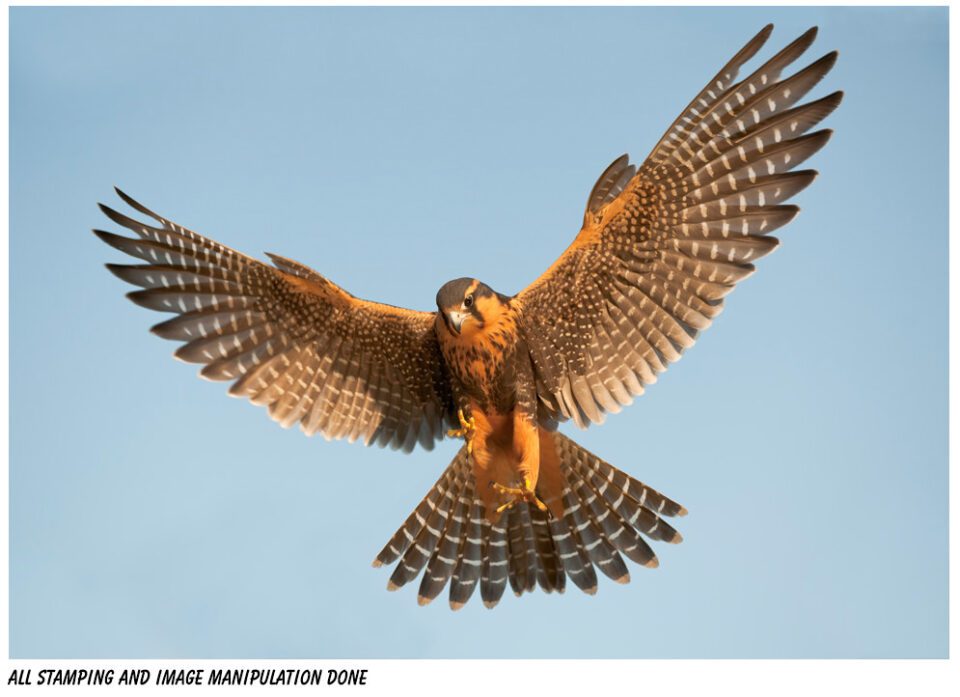
Aplomado Falcon Tutorial Steps 05 - At this point if yous were painting in color yous could now relieve this as a jpeg and bring into Corel Painter or GMX Painter or whatever pigment programme you lot are using. There are two things I want to do before painting, enlarge the canvas to give me more room to the edge (more work expanse) and turn the paradigm into blackness and white. I similar to paint or work in loftier dissimilarity black and white, when the white pops out, it makes the terminal print wait awesome.
- Below is my black and white image after conversion and adjustment of contrast and brightness, also you can see in this image how much extra room I gave myself for the groundwork. The blue edge represents how much I enlarged the canvas for that extra working space.
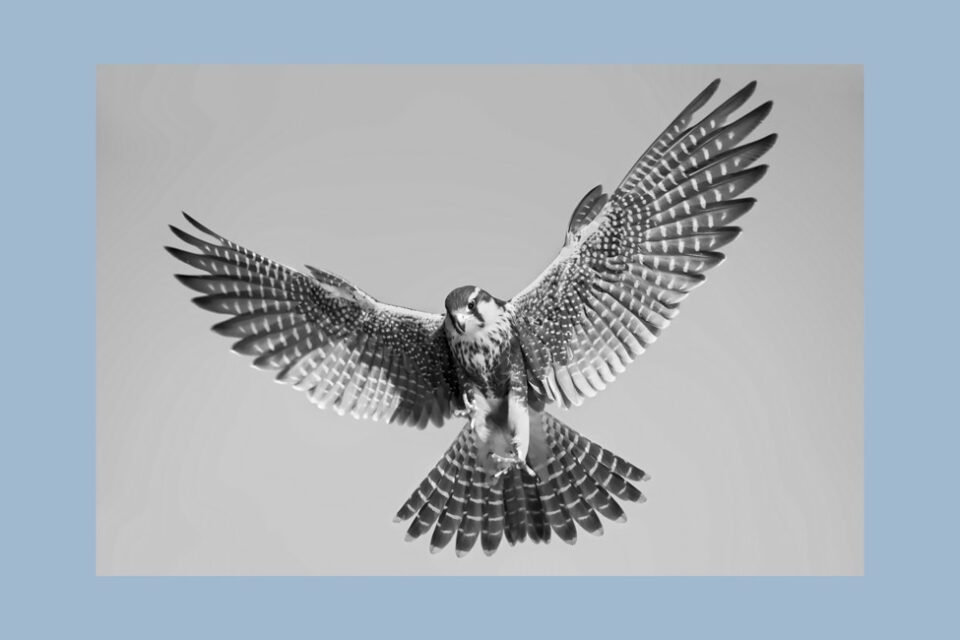
Aplomado Falcon Tutorial Final for painting
Permit The Painting Begin
Now I am going to bring the image into Corel Painter eleven and so I tin can start painting. Note that this isn't a tutorial on how to employ Corel Painter 11, that would make this document impossibly large and long. Please remember information technology doesn't accept to be Painter, it can be many dissimilar programs you apply to paint the photo, including Photoshop or the likes. Painter has some squeamish cloning features and brushes that make information technology my choice of tool. Having said this is non a review, I will touch on a couple items I use in Painter and the basic tools, but to help you lot forth.
The photograph below shows my epitome imported into Corel Painter and ready to go:
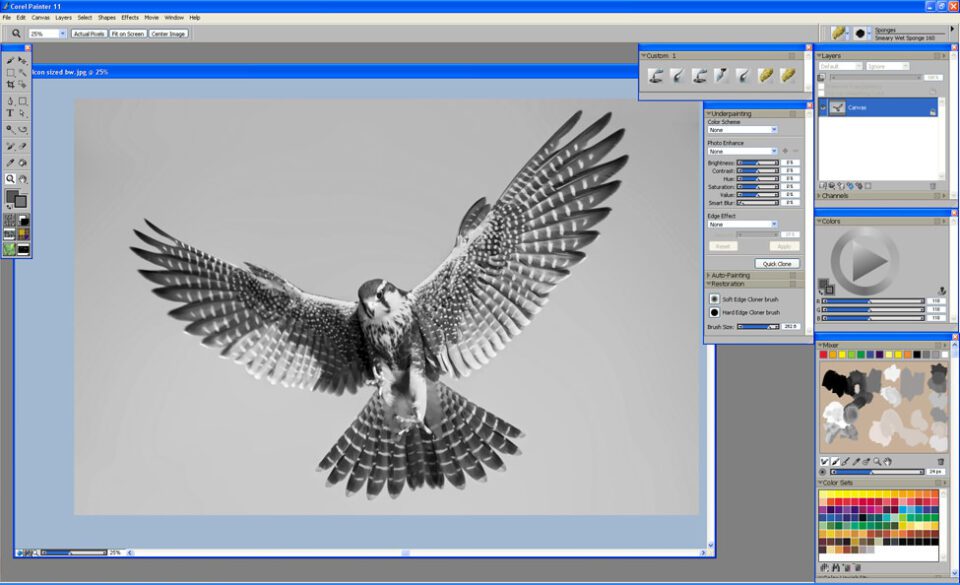
I am painting in mostly black and white, and take created a mostly blackness and white color palette. At this point it doesn't matter if you are painting in color or black and white, the process is the aforementioned.
The photo below shows the colors I like to use for my black and white series, occasionally I will let a piddling original color show through in the image as I did for the aroused eagle painting, it had hints of yellow in information technology. The xanthous tones were sourced from the original photo.
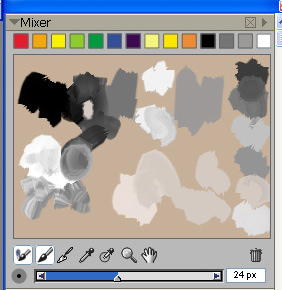
Open Corel Painter and load in your final JPEG paradigm, the 1 you lot are ready to apply as your reference file for the artwork. One time open yous need to quick clone it, then adjust the tracing newspaper transparency to suit what you lot like to piece of work with. The transparency is allowing you lot to see the original photo as an nether layer to the layer yous will pigment on. Kind of like how Disney did it with the old see through transparencies.
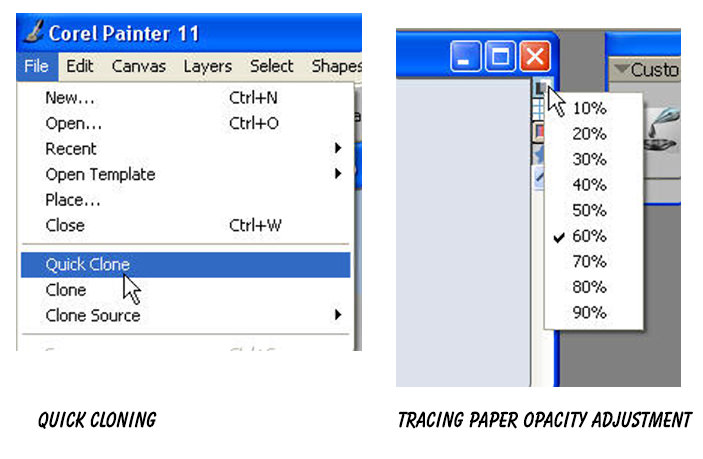
Setup a new cartoon layer; don't draw on the white canvass background. Rename it to something meaningful.
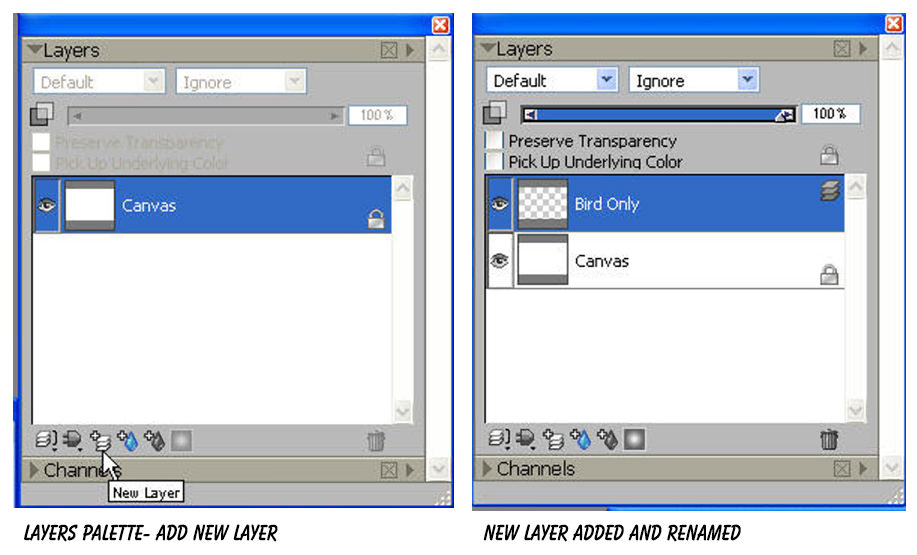
Now, before yous begin, fix a new layer to play on and just delete information technology when you are done. Go through all the diverse brushes that Corel Painter offers, find one or two where y'all like the strokes and the strokes adjust the manner for the subject. Then copy them to custom brush window so yous can easily select them during the painting process.
Corel Painter xi offers a huge choice of pigment brushes and pens, these brushes combined with a tablet produce awesome and realistic results. The newer versions of Painter are even better (I used 11 to create this tutorial). I firmly believe Painter is the all-time software in this category, which is probably why Corel can charge a premium price for it.
If you think the pick of brushes is huge, wait until you run across all the sub selections for brushes available for each castor and pen. The photograph below the bachelor brushes and also shows some of the sub brushes available in the acrylics section.
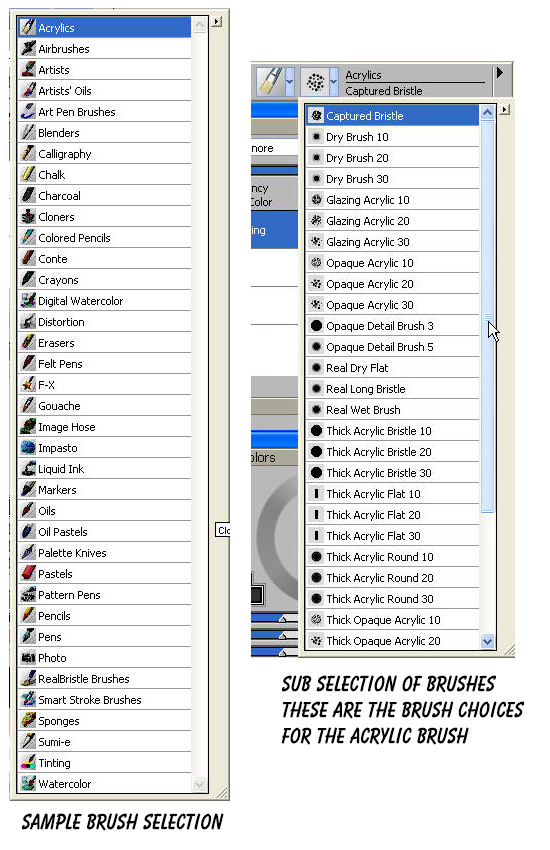
I often use a mixture of colors from my palette (in this instance generally black and white) and cloned colors from the original epitome, the tool that allows that selection is shown on below. When the little stamp tool shown is depressed and the color selector grey then Corel Painter is going to attempt and pick up the colors for the brush from the original source prototype. When tool is not depressed and at that place is colour in the selector yous are using the selected color. By alternating between the two methods you can create some actually cool artwork.
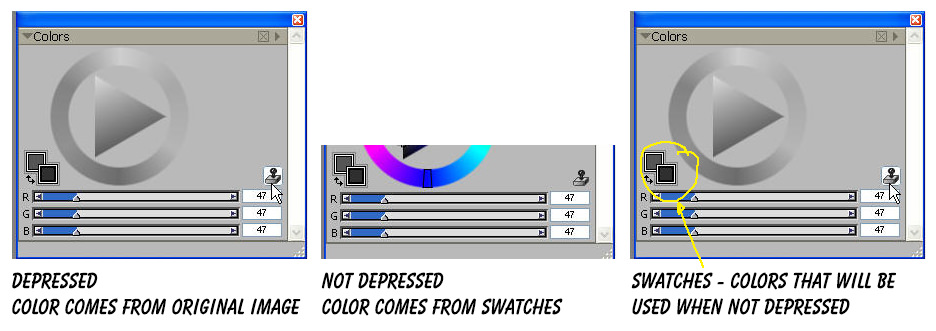
I apply the Sample Color tool to select from my mixer palette (shown left). I commonly leave information technology on that and take the main tool bar (shown below) gear up to painting. The other thing to consider when using cloned color or your palette colors is the transparency of the brush, this will touch the look on screen, below I show the same castor and colour painted with different transparency settings. Adjust this to the look and feel you want.
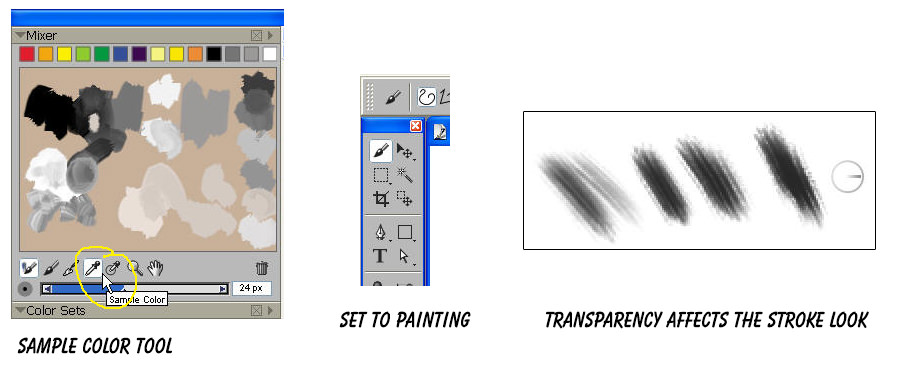
The transparency setting for the brush can be establish in the top toolbar as shown below.

I am going to use 1 of the acrylic brushes and get-go at the head. When you lot paint endeavour to follow the natural flow of the reference image, turn the tracing paper on and off oft to check your issue. The paradigm below shows the tracing paper toggle option.

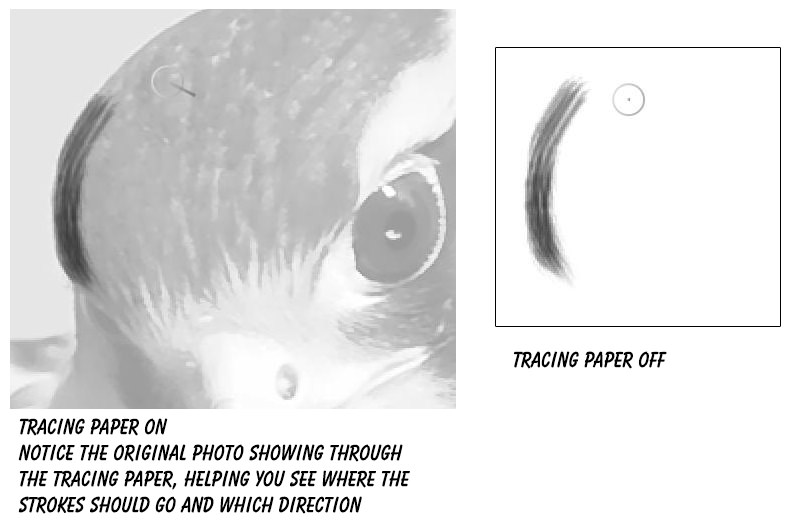
OK, get to painting, work it, work the angles, occasionally use clone color, try to pick upwards the details. Make it artistic and realistic, get creative. I started at the head, worked my way down the trunk and I followed the stroke management I see in the source. I follow the direction of the feathers and details.
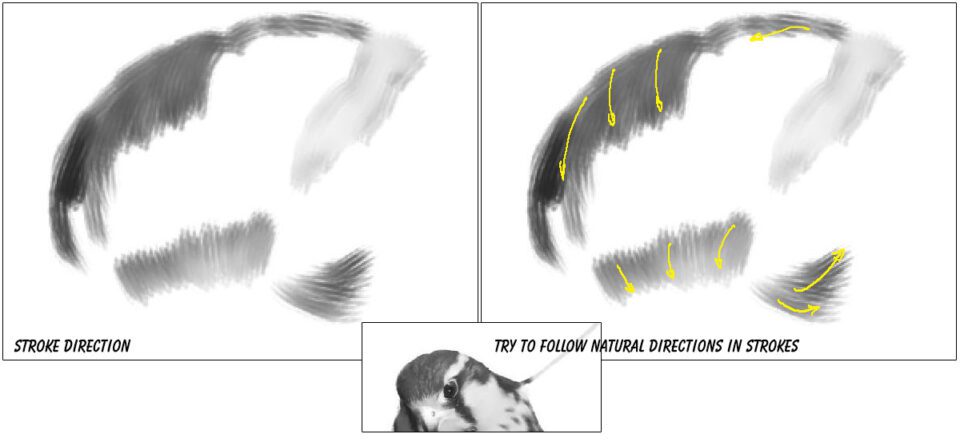
Later painting a section I occasionally switch to an acrylic dry castor to bring back some of the detail from the original photo, set the brush to choice up the color from the source image.
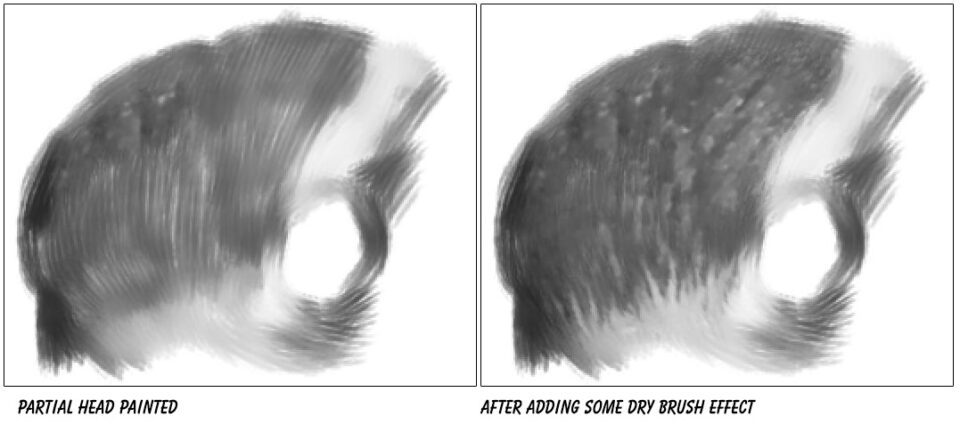
I am going to go ahead and paint a large section of the bird using the aforementioned techniques equally explained to a higher place. And so this is what it looks like with nigh of the body painted; now permit's branch out and do some of the wings.
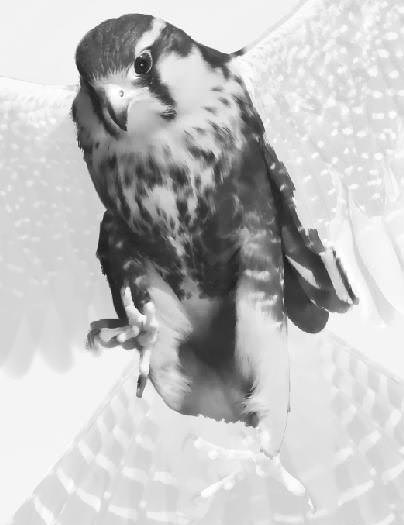
I am pretty much going to follow the same pattern every bit above to do all the wing sections and the residual of the bird. Remember to try to decide the best direction of your strokes, follow natural directions y'all meet in the underlying image.

Rotate the sail ofttimes to make your stroke flow, follow your natural hand movement and produce improve results. It will exist easier for you to follow forth the edges.
Essentially you are going to utilise the same technique to finish the whole bird, which I won't get through here. Why don't we add a bit of groundwork to the painting, first to become a feel for how it'due south going to look. Add a new layer for the background, fill it with a master color, I used a medium shade of greyness.
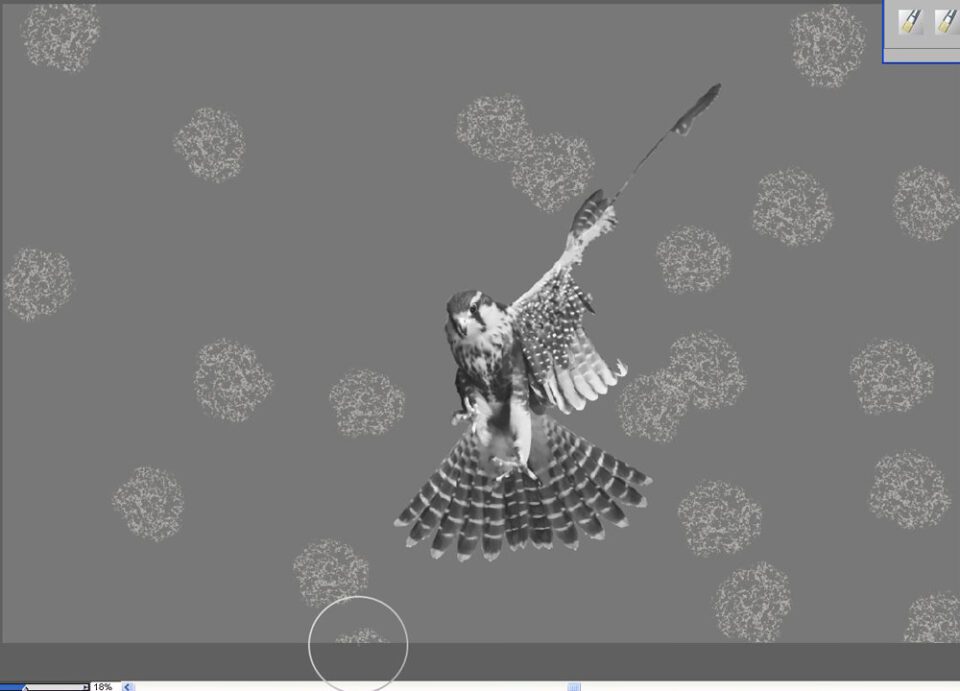
Then randomly paint some sponge blobs around the place, vary the color, select colors yous think adjust the mood you are trying to create. Also vary the size of the brush. Below is the way I did it.

At this signal you may think it looks a bit busy or overwhelming, only we are going to tweak it. At present I am going to employ a moisture smeary brush to alloy and distort the background, you can run into the result on the left hand side of the image below. Essentially continue playing with the background until y'all are happy with the look.

Once I have the background looking the style I want it, I am washed with that part. Now I want to add a bit of a lighter color almost the border of the wings to separate the bird from the groundwork and also but because information technology is an upshot I like the wait of.
Enable tracing paper so you can see the full outline of the bird or bailiwick y'all are painting, lets add some white pigment strokes in strategic areas along the edges of the wings. The images beneath show the idea. The left epitome is tracing paper enabled and I am painting white strokes along the fly tips. The middle image with tracing paper disabled ameliorate shows what I accept done with the white strokes. The terminal paradigm on the correct shows the strokes after I have smudged them to blend in better with the background.
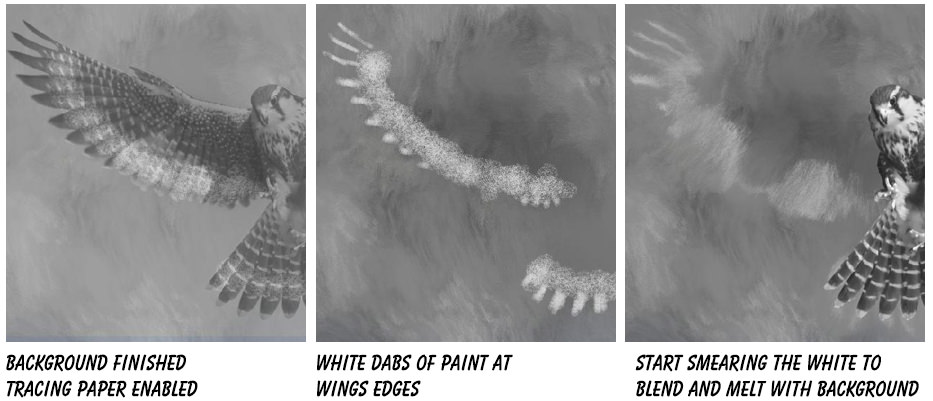
The effect I was going for was to have a slightly lighter colour along the wing tip edges as shown below.
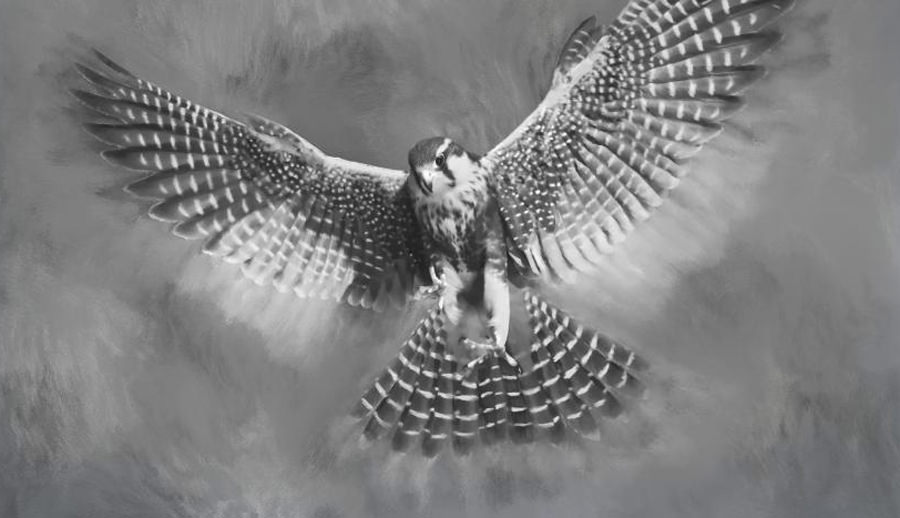
At this point you could be satisfied with the terminal prototype and leave it at that, I am going to apply Photoshop to add move trail to the edge of the wings to convey the effect of movement in the picture. It might be over doing information technology to some, but call up this is art and at that place are no rules, just like in photography, right?
Motion Trail Effect using Photoshop
Now lets go through the steps needed to add together a motion trail like effect to the wings of the bird.
Create a new layer in Photoshop above your painted epitome. Paint solid white lines along the bottom edges of the wings where you want the movement trail issue from, use a solid edge castor, we don't desire any transparency in the white line.

Now we need to add racket to those white lines, add noise, select Gaussian and Monochrome and you tin can pretty much ready amount to full.
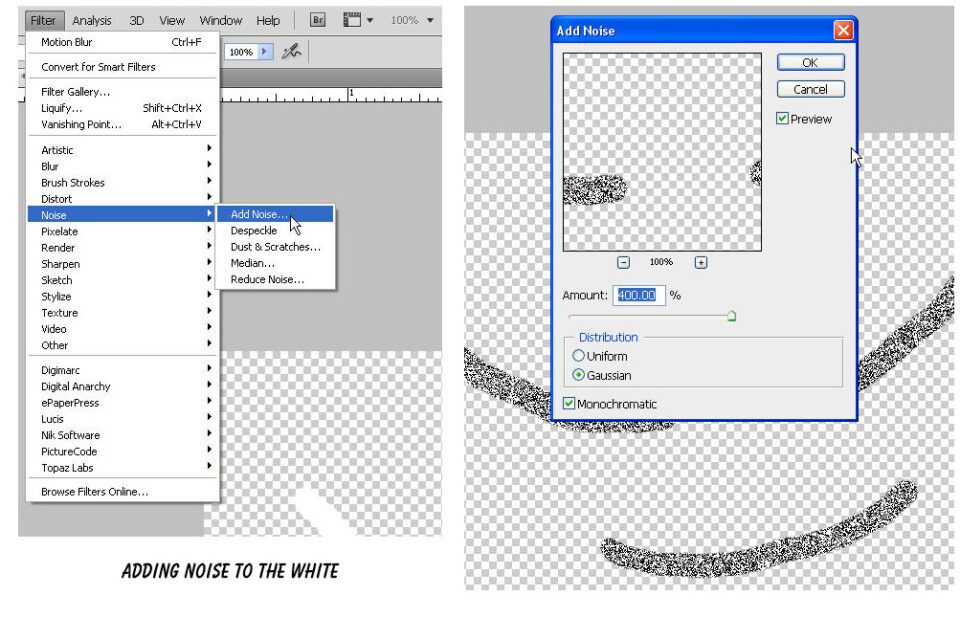
Next we are going to brand that noise a little chunkier using the Crystallize filter from Photoshop.
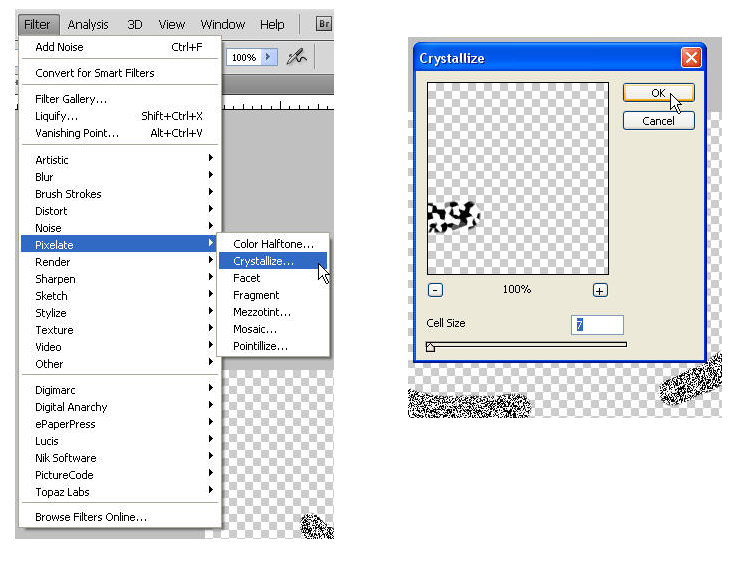
The jail cell size setting will depend on the original size of your paradigm, in this instance I ready mine to vii. We need a sharper separation between the white and black in the crystallized effect, nosotros tin can practise this with the threshold filter in Photoshop.
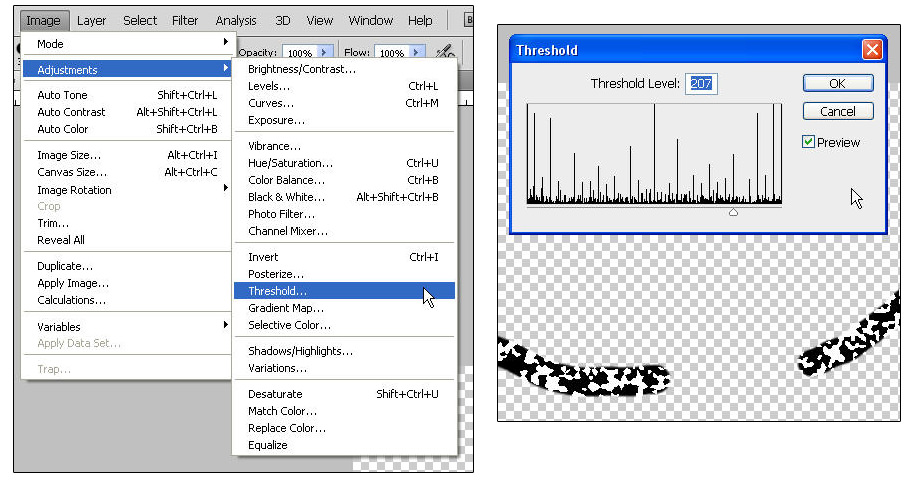
Y'all can see the difference betwixt the non crystallized and crystallized versions in the ii images beneath.

Now we need to become rid of the black and simply go out the white portion using the select colour range tool in Photoshop.
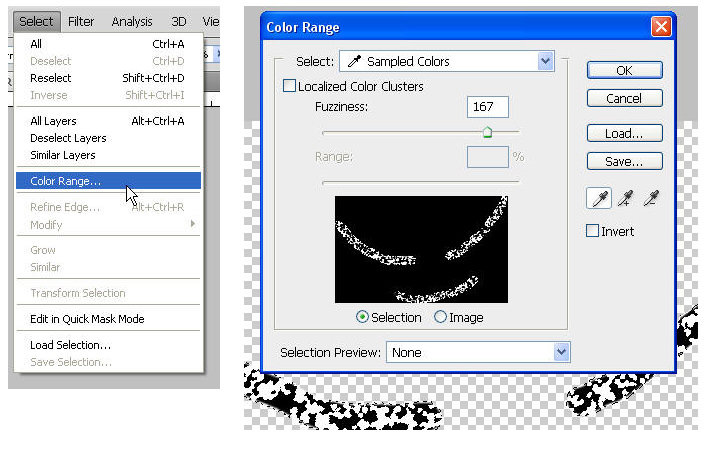
Select the black portion of the image and delete it, just leaving the white.
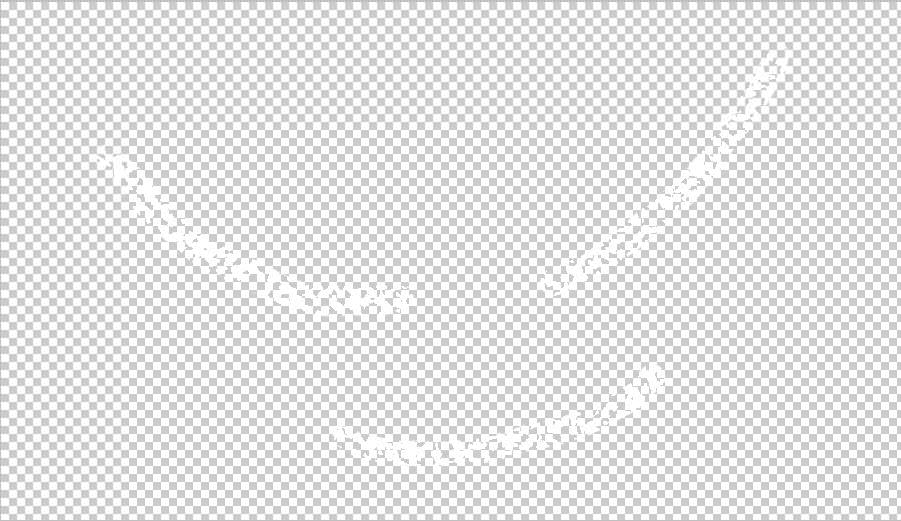
The image in a higher place shows the upshot after removing the black, its hard to run across with the squares of the transparent background, but we got what we wanted which was to only go out the white.
At present it is fourth dimension to plough those white lines into a motion trail using the move blur tool in Photoshop.
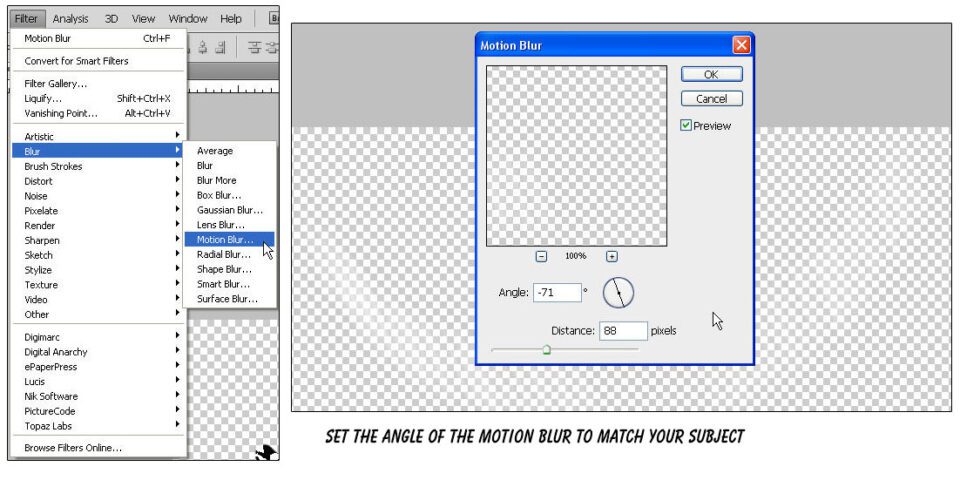
Set the angle of the motion to match your subject area, adjust the length (altitude) to the effect you are looking for, and then click ok to employ. That'south it, nosotros are almost done.
Here is the end event with a blackness groundwork (temporarily added), just so y'all can see the consequence improve.
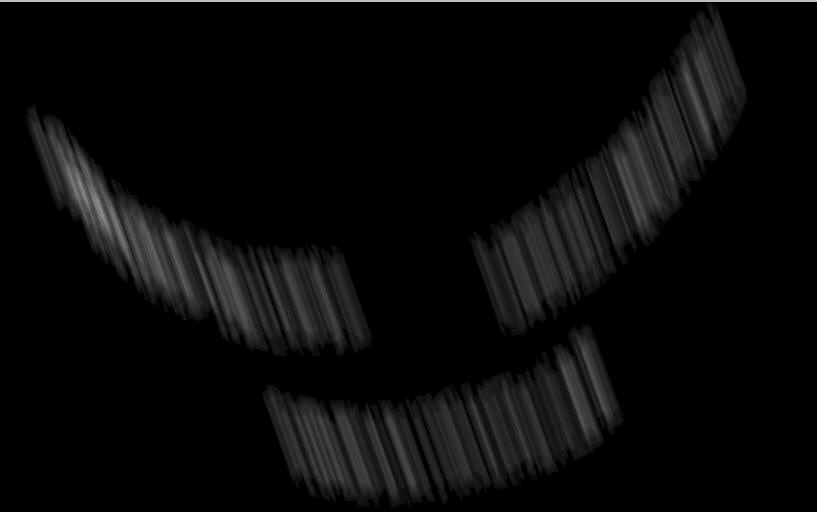
Move the trail into the best position, simply at the edges of the wings. Nosotros demand to do some tidy upwardly, the motion trail is in places we don't desire it. We can either create a mask from the bird layer in the original Painter file or just use the delete tool in Photoshop. For this exercise I am just going to delete the troublesome areas.
Here is my corrected result, discover I deleted the areas where the motion would go over the elevation of the wings. The blackness background is but and so y'all can run across the trails better.
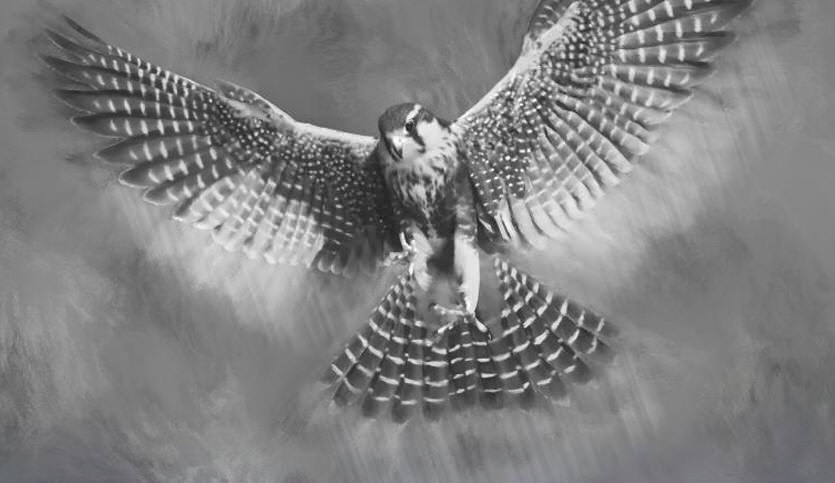
Now we need to soften the outcome a piffling so information technology is not then defined, suit the transparency of the layer containing the movement trails until you are happy with the final await. I concluded upwards adjusting my layer transparency to 47 percentage.
This is where I am going to exit the tutorial at, I promise yous accept enjoyed it and plant it of some use.
For my final epitome, I added a ghost-like effect to the fly tips, I did this past enlarging the image slightly, masking out everything simply what I wanted to be seen, adjusting the transparency to the level I wanted. There is nothing special about how I did it, I just figure I will exit something out of the tutorial and let your imagination do the work.
Lets finish by showing the before and afterwards images one last time, happy painting everybody.

And finally a higher resolution paradigm of the final artwork.
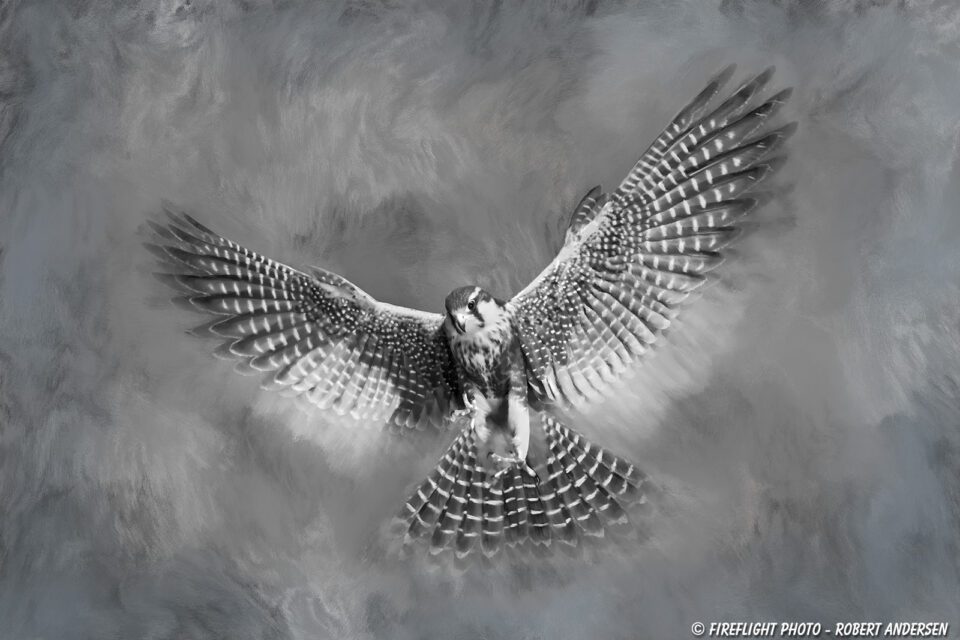
Call up, this kind of creative painting tin can exist done to any kind of photo, let your imagination run wild and maybe fifty-fifty utilize some of those 'weep shots' for some terrific artwork. Take fun.
Source: https://photographylife.com/turn-your-photo-into-artwork
Posted by: youngallind.blogspot.com


0 Response to "How To Take A Photograph And Turn It Into A Drawing On Photoshop"
Post a Comment